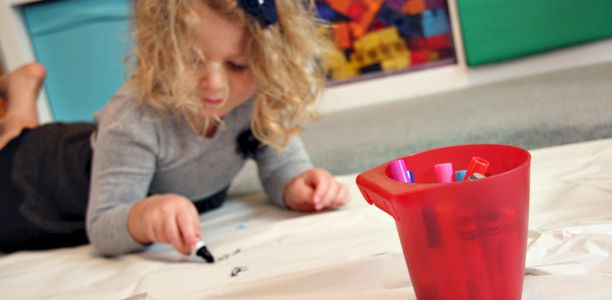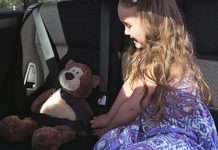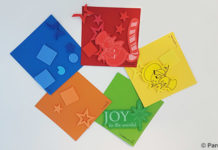Age
Two years and up
Duration of activity
This activity can last just a few minutes, or for hours if you have older children.
Materials/equipment
- Butcher’s paper
- Colouring pencils, crayons, textas or paint
- Stickers, stamps, glitter or other crafty things to decorate the paper with.
Cost
The cost of this activity is minimal. Your local butcher will probably give you a few sheets of paper. You can use any art or craft supplies you have lying around the house, rather than going out to buy new ones. Even if you do spend a few dollars buying supplies, the finished product will almost certainly be cheaper than buying wrapping paper from the shop and your child has the educational benefits of engaging in the craft activity.
Preparation
- Protect flooring with old sheets or do in the garden.
- Gather large sheets of butcher’s paper and art and craft supplies.
- Dress your child in old clothes if you are using art supplies which might stain them like paints.
What to do
 Ask your child to decorate the butcher’s paper using the art and craft supplies. They can do any design they like.
Ask your child to decorate the butcher’s paper using the art and craft supplies. They can do any design they like.- As they draw, paint or glue, talk to them about the design they make. For example you could discuss the colours they use, the size of the things they draw or the things which their decoration represents (e.g. people, animals or Christmas).
- Encourage your child to decorate the entire sheet of butcher’s paper and congratulate them when they persist for long enough to do so.
- Put the paper somewhere safe to dry and store it until you have a special present to wrap (or make a present like a magnetic chalkboard to give a friend if you want an excuse to use it straight away) .
Tips
- Be aware that butcher’s paper may rip if it gets too wet, for example for thick blobs of paint.
- You can also use paper included in packaging or buy large rolls of paper inexpensively from departments stores (e.g. Ikea).
- Encourage your child to think about the people whose presents they will wrap with the paper they make, to increase their excitement.
- If you plan to use paint, this activity might be better completed outside or over old sheets on tiled areas.
Educational outcomes
 Understanding self, family and community
Understanding self, family and community
The gift wrap that you make can be used to wrap presents for special people in your child’s life (and what grandparent wouldn’t be proud to get a gift wrapped in paper handmade by their grandchild!?). As you make the paper and talk about these people you’ll also be helping your child develop an understanding of the people who make up their family and the different roles they play. They will probably be proud of their creations and when they do this they’re demonstrating their increasing understanding of themselves and their abilities.
Fine motor skills
Drawing, painting, stamping and other tasks your child will need to create their own wrapping paper are all great ways to develop their fine motor skills. As they pick up and manipulate pencils, brushes and paper, they’ll be developing the muscles in their fingers which control fine movements, such as those made when turning the page of a book, drawing or writing. They’ll also be developing their hand-eye coordination.
Language and communication skills
Playing games and making things with your child is also a social time when you communicate by talking, as well as using facial expressions and gestures. Help them learn by using meaningful gestures and expressions and speaking in clear language. Give them opportunities to speak and listen and help them pronounce new words. Ask questions and listen to their answers. You’ll notice your child’s answers become increasingly elaborate and they begin using new words in increasingly complex sentences as they grow older.
Creativity and curiosity
Making wrapping paper is a great activity for your child to explore their curiosities and get creative. Younger children may be curious about the feel of different art supplies and will probably enjoy feeling paint on their hands as they finger paint. Don’t be surprised if they demonstrate their curiosity about the taste of pencils, paints and glue by trying to eat them (and ensure you use non-toxic products in case they do). They may want to draw pictures which communicate recent experiences (such as a day trip they enjoyed) or represent people or things they love.
Maths skills
Your child’s understanding of mathematical concepts like shapes, patterns, size and colours will develop as they make their wrapping paper. For example you could talk to toddlers about the size and shape of the objects they draw on their paper and pre-schoolers about the relative size of the objects they draw. Older children aged 6-11 who are mastering the art of drawing and writing can create complex patterns using different colours and shapes. They will probably enjoy using mathematical instruments like rulers to measure the distance between the objects they draw or a protractor to draw shapes or measure their angles. As they do so they’ll be improving their understanding of important mathematical concepts like measurement and geometry.
References
- Virginia Early Childhood Development Alignment Program. Milestones of child development- A guide to young children’s learning and development from birth to kindergarten. 2009. (cited 26 July 2013). Available from: (URL Link)
- Queensland Health. Physical and cognitive milestones. 2007. (cited 31 July 2013). Available from: (URL Link)
- Australian Curriculum and Reporting Authority. Australian Curriculum- Mathematics. Undated. (cited 2 October 2013) Available from: (URL Link)



 (13 votes, average: 4.69 out of 5)
(13 votes, average: 4.69 out of 5) 






